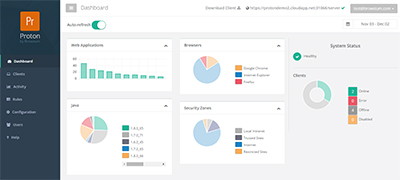News
Browsium Releases New Browser and Web App Tracking Solution
Browsium today rolled out a new tool for tracking compatibility issues associated with Web applications and browsers.
The new Proton product is a reporting system that lets IT pros see what Web applications being used, as well as the frequency of use. The solution tracks browser versions for Chrome, Firefox and Internet Explorer. It also tallies the browser add-ons being used, including ActiveX controls and Java versions. Users get reports from the system in the form of tables and charts.
Browsium Inc. specializes in tools to address Web application issues, so the Proton product adds to the company's existing product line. The company also makes an Ion Web application remediation solution, plus a Catalyst multiple browser management tool.
The Proton solution consists of three parts, a database server, a client add-on and a browser-based dashboard for analyzing data. The Proton Server is based on Windows Server running IIS and SQL Server, which can be run on premises or hosted, according to Browsium's white paper (PDF). The Proton Client gets installed on premises and adds an add-on to browsers that collects inventory data for analysis using Proton Manager, which is a service maintained by Browsium. IT pros get a dashboard view of the data via Proton Manager, as in the following example:
 [Click on image for larger view.]
The Proton browser and Web app tracking solution. Source: Browsium white paper (PDF).
[Click on image for larger view.]
The Proton browser and Web app tracking solution. Source: Browsium white paper (PDF).
Microsoft has its Enterprise Mode tools to address browser compatibility and Web app migration issues that organizations typically face, but it's been somewhat of a latecomer to the issues. Meanwhile, Browsium has been one the pioneering companies addressing those pain points.
Microsoft recently updated its Internet Explorer Enterprise Mode tools to help alleviate migration issues. It also offers a free inventory tool called the "Enterprise Site Discovery Toolkit." However, that toolkit isn't an automated solution like Proton, per Browsium officials. It's a "bare bones" solution. Moreover, the Microsoft Site Discovery Toolkit only works with Internet Explorer and it won't indicate what's happening with Chrome or Firefox, according to Gary Schare, Browsium's president.
"The Microsoft Site Discovery Toolkit was built by Microsoft as a building block to creating a solution," said Schare, who is also a former 14-year Microsoft veteran. "So it does single-machine logging into a structured log file, and it's up to the customer to then take all those logs across all of those machines and build a solution that integrates them into a database. It allows you to manually correlate things and sift through the data. Proton is an end-to-end solution, so it collects more data than Microsoft does by quite a large amount. It has a backend server built in so the clients automatically send the data to the server. The server automatically cross-correlates everything into the database and then presents it in prebuilt reports, which we will be enhancing as we get feedback from customers."
Browsium built Proton after listening to customer requests. Schare explained that IT pros mostly know of a handful of Web applications that need migrating. They needed more information about what was being used.
"They have no good inventory of Web apps used across the organization," he said. "New ones come online all of the time -- either deployed internally by teams or by people signing up for some SaaS solution. And IT has no insights. They don't know what they're going to break when they upgrade the browser, release a Windows or browser patch, or release a new version of Java. So they basically do trial and error -- they throw it out there and see if anyone complains."
Microsoft has given organizations until Jan. 12, 2016 to move to Internet Explorer 11 under a revised support policy announced last year. That's increased the pressure on some organizations that need to maintain so-called "legacy" Web apps, which may depend on older Java versions to run. Not every organization will make Microsoft's deadline.
"Customers fall into three categories," Schare said. "First they are actively working to get to IE 11 by Microsoft's deadline of January 12 or they've gotten there already. Second are those organizations that cannot, and will not, make it to the January deadline, which is a very large number of customers, and they'll wind up buying Custom Support from Microsoft. So, it means for a bunch of large enterprises, 2016 will be the year they put in the effort to migrate to IE 11. And a third category is represented by those organizations that are playing 'security chicken' to some degree with Microsoft. They're hoping Microsoft will give them the patches or they'll just take the risk, which is obviously not a great thing to do."
One make-shift approach is to use Browsium's Catalyst tool to specify that Internet Explorer runs intranet apps, while Chrome or Firefox is used for Internet browsing, Schare said. Paying for Microsoft's Custom Support is an option, but "the fees generally escalate year by year," and Microsoft hasn't indicated what the support costs will be for IE 11 migrations, he added.
Browsium offers a 30-day Proton evaluation kit. It also will host a Web presentation about the new Proton product on Dec. 16, accessible via a signup page.
About the Author
Kurt Mackie is senior news producer for 1105 Media's Converge360 group.